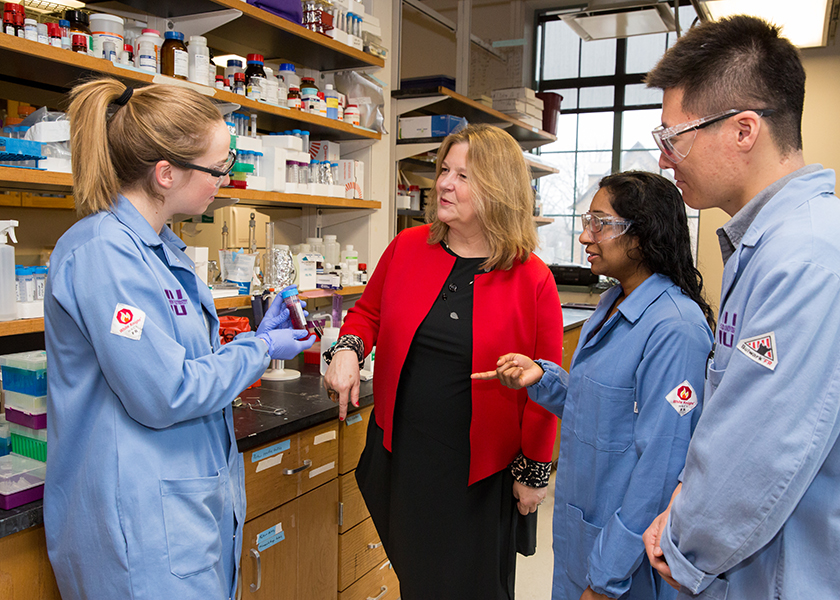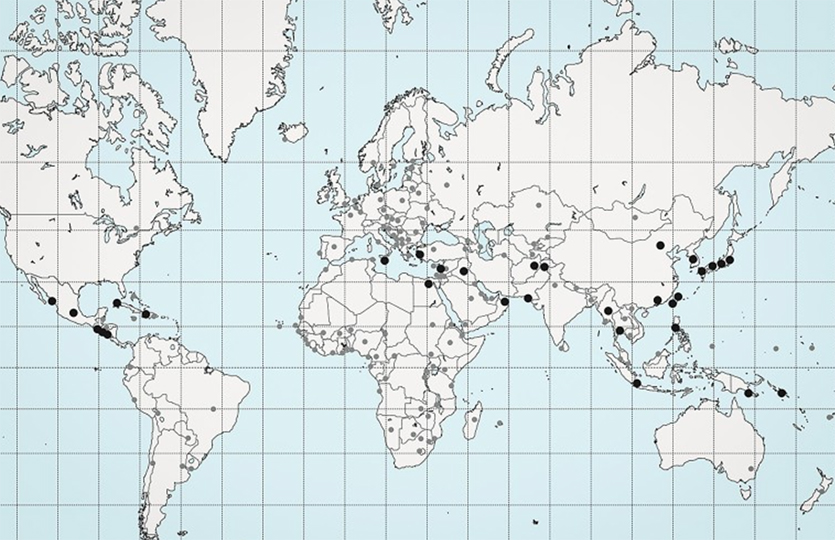Future-Proofing US Embassies and Consulates
CEE experts reimagine how hundreds of diplomatic locations around the world can prepare for climate change

US embassies and consulates are designed to withstand a diverse set of dire, yet plausible, threats. These secure buildings are blast-proof, bullet-proof, fire-proof, natural disaster-proof, and even gas-proof.
Now, Northwestern Engineering experts want to make them climate-proof.
In partnership with the US Department of State Bureau of Overseas Buildings Operations (OBO) and Chicago-based architecture firm Krueck Sexton Partners, Northwestern civil and environmental engineers have spent the past five years reimagining the United States’ more than 280 diplomatic locations around the globe — specifically embassies and consulates. The OBO is the single property manager for the planning, acquisition, design, construction, operations, maintenance, and disposal of US governmental diplomatic and consular property overseas. Diplomatic properties include embassies, consulates, office space, diplomatic housing, and marine guard residences.
The final designs of this project ensure that these buildings remain safe, secure and functional while increasing their resilience to climate change, technological advancements, population shifts, urbanization, and resource scarcity.
The project’s roadmap, “Embassy 2050,” was completed this summer. The State Department currently is determining how to implement various aspects of the project into its six-year capital plan.
“Climate change isn’t just a threat; it’s a threat multiplier,” said Northwestern’s Kimberly Gray, who co-led the project. “Extreme heat and droughts, for example, can lead to failed agricultural production and, ultimately, famine. Famine, then, foments political unrest, which can put embassies at risk. ‘Embassy 2050’ represents our vision of how the world might look in 25 years and how embassies can become a symbol of American innovation while tackling rapidly changing climate head on.”
“The State Department decided to embark on the ‘Embassy 2050’ project to proactively address the future challenges that embassies and consulates might face in the coming decades,” said the State Department’s Curtis F. Clay. “Embassy 2050 stems from the recognition that global drivers, including climate change, technological advancements and shifting worldwide demographics, are evolving threats that will significantly affect the way embassies and consulates operate. It anticipates these changes and guides the development of more resilient, sustainable and adaptive diplomatic missions. By planning ahead, the State Department can ensure that its diplomatic facilities remain effective in representing national interests, protecting personnel and promoting international cooperation, even as the global landscape continues to evolve.”
An expert on sustainability, Gray is the Roxelyn and Richard Pepper Family Chair in Civil and Environmental Engineering at the McCormick School of Engineering. Clay is the director of Architecture in the State Department’s Bureau of Overseas Buildings Operations.

“Few buildings and sites are more intricately integrated than an embassy compound”
With approximately 175 embassies and 90 consulates, OBO manages an extensive portfolio of diplomatic properties. These facilities are more than individual buildings. Most embassies comprise a collection of buildings on a compound, which must reconcile diverse objectives. Embassies and consulates must be secure yet welcoming, aesthetically pleasing yet functional — all while creating diplomacy with the host nation.
“Few buildings and sites are more intricately integrated than an embassy compound,” said Mark Sexton, an architect with Krueck Sexton Partners and adjunct lecturer at Northwestern Engineering. “It’s like a hospital but even more complex. Depending on its location, an embassy might have hundreds or even thousands of people working there. When designing an embassy building, you must follow many rules to ensure these people stay safe. With so many rules, it’s difficult to pinpoint small areas of opportunity, where we are free to innovate.”
If anyone is keenly aware of the various requirements involved in embassy design, it’s Sexton. Since 2013, Sexton has worked with the State Department to update and renovate embassy buildings. Each year, the Department conducts a comprehensive evaluation of its embassies, including associated warehouses, annexes, shops, housing and maintenance and support facilities. As a part of the evaluation process, staff members review data related to four key areas: facility condition, physical security, natural hazard resilience, and effectiveness when conducting diplomacy.
“We use these metrics to rank OBO’s portfolio of functional facility assets that are available for potential projects,” Clay said. “Through this process, OBO evaluates multiple options to address facility deficiencies and maintenance backlogs.”
The challenge is to design systems that will survive for 100 years
Instead of relying on a year-to-year evaluation, Sexton wondered if experts could extend their gaze further into the future. Rather than scrambling behind the rapidly changing climate, the State Department could get ahead of it — and serve as an example of leadership for the rest of the world.
“Embassies are built to last for 100 years,” he said. “But climate and technology change faster than that and are difficult to predict. How do we design systems — the building and all the elements within it — in a way that will survive for 100 years?”
Sexton posed this question to Gray, who has conducted extensive research into building sustainable cities. Together, they assembled a team of Northwestern experts and asked them to develop a roadmap for the future of embassy design. The Northwestern team includes Giuseppe Buscarnera, Giorgia Chinazzo, David Corr, Gianluca Cusatis, Robert Dalrymple, Yu (Marco) Nie, Alessandro Rotta Loria, Amanda Stathopoulos, Matthew Troemner, and George Wells — all from the department of civil and environmental engineering.
“An embassy is more than a building,” Gray said. “It’s more than a place to house diplomats, their families and security personnel. It’s a cultural representation of the US and should have a positive effect on the region. We got together to form a vision of what the world might look like in 2050 and then imagined an idealized version of how embassies could transition to fit into that vision.”
Years the CEE team spent reimagining US installations
Transitioning to sustainable, reliable energy
Of course, the vision contains sustainable energy. It would be difficult to future-proof a building if it relies on energy from finite resources like fossil fuels. Typically, diesel generators provide power for embassies. Although they are reliable in remote or conflict-torn regions, diesel generators use unsustainable fuel and generate pollution, including particulate matter and climate-warming greenhouse gases.
But, as long as diesel fuel is available, embassies will retain electricity — even if the surrounding city experiences a sweeping outage.
“Generators don’t rely on the power grid, so they work in remote areas with unreliable power sources,” said Rotta Loria, the Louis Berger Associate Professor of Civil and Environmental Engineering at Northwestern Engineering. “From the perspective of ease and efficiency, generators have their advantages. But the problem is that fossil fuels will become more expensive as supplies diminish, and, eventually, we will run out.”
In the report’s section on energy, Rotta Loria, Wells, and Gray propose transitioning embassies from a single-source, uniform reliance on fossil fuels to a mix of diverse, renewable sources, including solar, wind, tidal, and geothermal energy.
“For reliability, it’s important to integrate multiple renewable energy technologies,” Rotta Loria said. “But that doesn’t mean we need a complicated scheme with 10 systems. We could just combine two sources, like solar and shallow geothermal, also known as geoexchange.”
Water: From a linear to circular approach
According to the new report, water usage also presents an opportunity for increasing sustainability. Currently, embassies follow a linear approach. People turn on the faucet, use water and then wash it down the drain. From there, it travels to a centralized water-treatment plant, assuming the city or area has one. There, the water is exposed to carbon and energy-intensive purification processes.
“I call this the ‘take, make, waste’ model for water management,” said Wells, an associate professor of civil engineering. “There are a lot of downsides to this model. It’s expensive, extremely energy intensive and produces a lot of greenhouse gases. We want to transition away from this linear model to a circular model for water management.”
Specifically, Wells proposes reusing lightly used water, or “grey water,” without sending it off-site to a water reclamation plant. Drinking water becomes grey water after being used to wash clothes, for example. In other words, it’s water that has been used but is unlikely to contain pathogens. Wells imagines filtering it onsite and reusing it for cleaning, watering plants and other household needs.
“In our conventional view of water management, we source water from either high-quality pristine lakes and rivers or protected groundwaters,” Wells said. “Of course, those are great sources for water. But, in an area with water scarcity, we must expand the boundary of where we can find water. We can divert grey water from more contaminated water and reuse it right on site.”
Building for comfort, productivity and quality of life
In another section of the report, Chinazzo, an expert in human-building interactions, proposes a novel approach to indoor environmental design. By personalizing indoor environments, building managers can enhance comfort and productivity while significantly reducing energy consumption.
“We are starting to see a lot of research about how what we eat and drink affect us,” she said. “But we still don’t know much about how our surrounding environment influences us. How does our indoor environment affect our productivity, mood or even our sleep at night? I’m exploring ways to design our built environment so that it can improve our quality of life.”
To meet this goal, Chinazzo imagines integrating personalized, targeted solutions to enhance the comfort of individual people living and working inside an embassy. Temperature control, for example, is an area where people have highly individualized preferences. And, to complicate matters, embassies do not allow workers to open windows. To address the issue, building managers typically take a one-size-fits-all approach.
“In this situation, many offices turn on the air conditioning,” said Chinazzo, an assistant professor of civil and environmental engineering and director of Northwestern’s Architectural Engineering and Design Program. “Then, the person who prefers warmer environment turns on a space heater. If the conditions are not optimal, then people react and consume more energy until they are comfortable.”
Instead, Chinazzo recommends providing personalized comfort systems. This could include desk fans and chairs with built-in heating and cooling features. Similarly, embassies can follow this personalized approach to lighting, ventilation and controlling ambient noise.

The roadmap is complete, so what’s next?
In the face of increasing climate-related threats, the physical security and operational continuity of diplomatic facilities overseas is paramount. Climate-proofing US embassies and consulates also demonstrates a commitment to sustainability and resilience, inspiring other countries to take similar actions.
Now that the final roadmap is complete, the State Department is reviewing opportunities to integrate Northwestern’s proposed solutions into its buildings.
“The final Embassy 2050 report has exceeded our expectations and now the difficult work of implementation begins,” Clay said. “The rigor and future forward thinking developed by the team at Northwestern has positioned the government to understand the breadth of the risks and the impact our work has on not only industry, but architecture and engineering disciplines as well.”